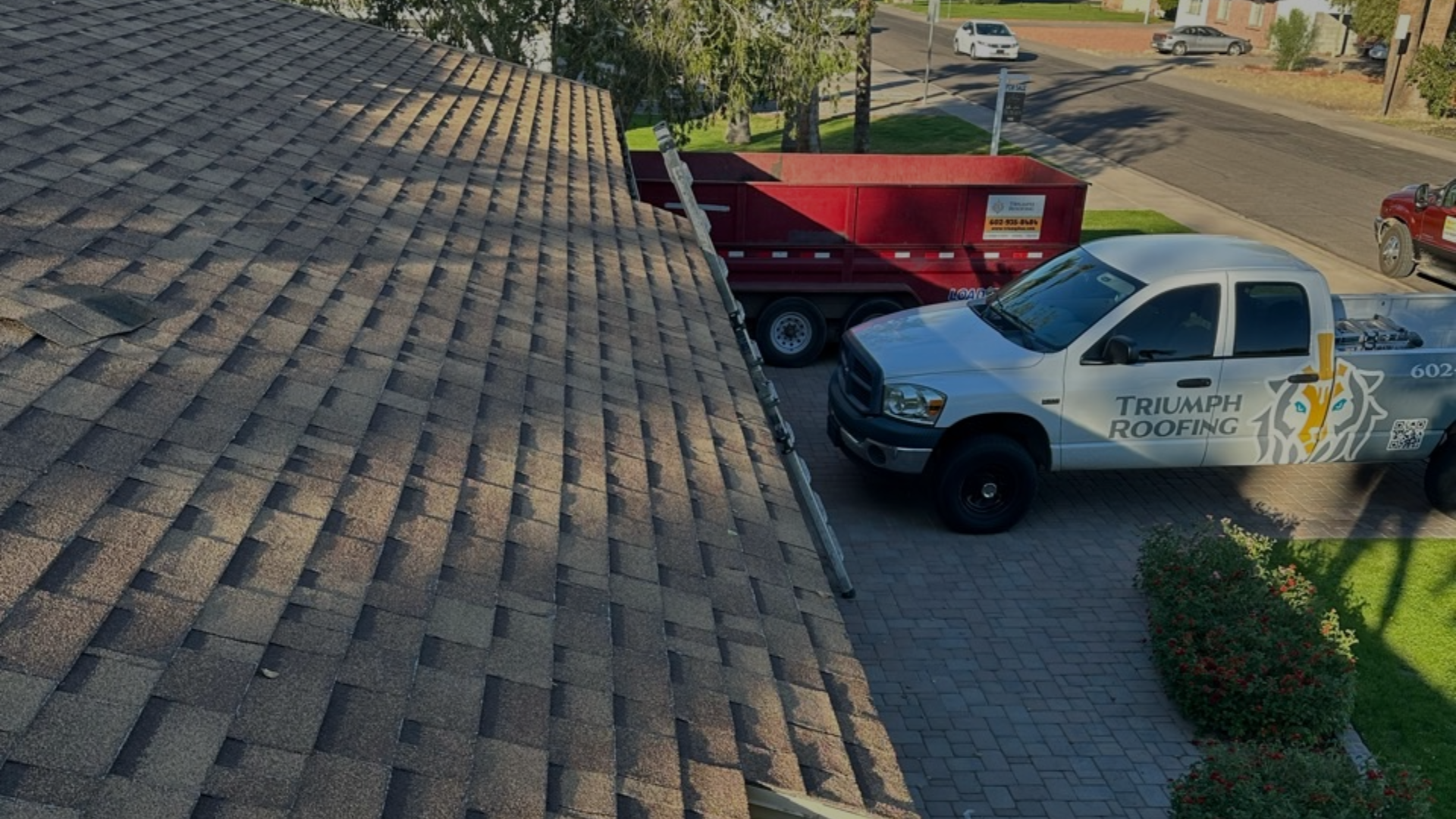
Arizona’s Most Common Roof Problems
Arizona’s unique climate presents specific challenges for homeowners when it comes to roofing. The intense heat, desert environment, and monsoon season can wreak havoc on your roof if not properly maintained. To help you protect your home, here are some of the most common roofing problems you might experience in Arizona:
Sun Damage
Arizona’s sun is one of the primary culprits for roof damage. Constant exposure to intense UV rays can cause:
- Thermal Shock: Rapid temperature fluctuations between day and night can cause roofing materials to expand and contract, leading to cracks and damage.
- UV Degradation: Over time, the sun’s rays can break down the protective granules on asphalt shingles, reducing their lifespan and effectiveness.
Weather Damage
Arizona’s monsoon season brings heavy rains, strong winds, and even hail, which can cause significant damage to your roof. Common problems include:
- Roof Leaks: Heavy rainfall can expose weak spots in your roof, leading to leaks and water damage.
- Wind Damage: Strong winds can lift shingles, damage flashing, and even cause entire roofs to be ripped off.
- Hail Damage: Large hail stones can dent or puncture roofing materials, requiring repairs or replacements.
Desert Debris and Wildlife
Arizona’s desert environment poses additional challenges for homeowners.
- Debris Buildup: Dust, sand, and debris can accumulate on your roof, blocking drains and gutters and causing damage to roofing materials.
- Wildlife: Birds, rodents, and other animals can cause damage to your roof by nesting, chewing, or creating entry points.
Common Signs of Roof Trouble
It’s important to regularly inspect your roof for signs of damage. Some common indicators include:
- Missing, cracked, or curled shingles
- Leaking or water stains on ceilings or walls
- Damaged flashing around chimneys, vents, and skylights
- Sagging or uneven roof surfaces
- Moss or algae growth
If you notice any of these signs, give us a call at Triumph Roofing for a thorough inspection and repair.
Preventing Roofing Problems
While it’s impossible to entirely prevent roofing problems, regular maintenance can significantly extend the life of your roof. Some preventative measures include:
- Regular Inspections: Schedule annual roof inspections to identify potential issues early on.
- Proper Ventilation: Ensure adequate attic ventilation to prevent heat buildup and moisture accumulation.
- Gutter Cleaning: Regularly clean gutters to prevent clogs and water damage.
- Trimming Trees: Trim overhanging branches to reduce the risk of damage from falling debris.
By understanding the common roofing challenges you face as an Arizona homeowner and taking proactive steps to protect your roof, you can help ensure the longevity and integrity of your home. Triumph Roofing is committed to providing expert roofing services to Arizona homeowners. Contact us today for a free quote for your next roofing project!
Let's Talk About Your Roof.
"*" indicates required fields
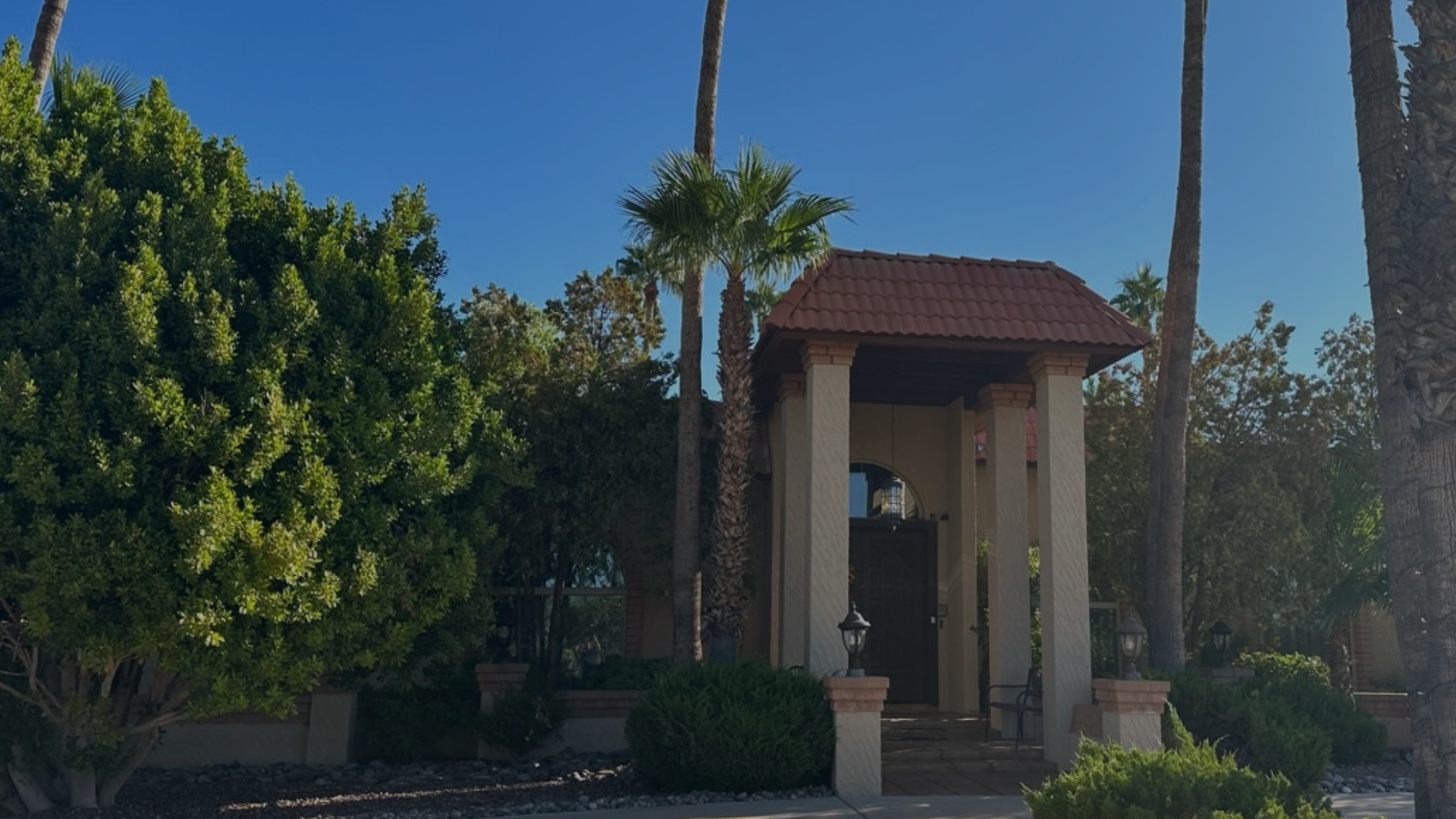
Why Choose Triumph Roofing for Storm Damage Roof Repair?
The aftermath of a storm during monsoon season in Arizona can be stressful. Damaged roofs leave your home vulnerable, and navigating the repair process can feel quite overwhelming. That’s where our team at Triumph Roofing comes in. We’re your one-stop shop experts from storm damage roof repair to residential roof inspections and more. We offering comprehensive services and peace of mind for your roof. Finding a reliable roofer during monsoon season can be challenging. Here’s why Triumph Roofing should be your top choice:
Fast and Reliable Response Time
We understand that time is of the essence after a severe storm. Exposed roofs are susceptible to further water damage, leading to costly interior repairs. We offer 24/7 emergency response and quick turnaround times. Our team will be on-site promptly to assess the damage and provide a clear action plan!
Experienced Storm Damage Specialists
Our roofers are not just skilled installers, they’re storm damage specialists. We understand the unique challenges storms present, from identifying hidden damage to selecting the most appropriate repair materials. This expertise ensures a thorough inspection, accurate estimates, and repairs that address the root cause of the problem.
High-Quality Materials and Workmanship
At Triumph Roofing, we believe in using only the best materials to restore your roof’s integrity and longevity. We source our shingles, tiles, and underlayment from trusted, industry-leading brands, ensuring lasting protection for your home. Furthermore, our roofers are meticulous in their work, adhering to strict industry standards and manufacturer specifications for a flawless finish.
Comprehensive Roof Repair Services
Storm damage can manifest in various ways, from missing shingles to punctured roof membranes. Triumph Roofing offers a full spectrum of repair services to address any issue, including:
- Shingle Replacement and Repair: From replacing missing shingles to patching minor leaks, we’ll ensure your roof is watertight again.
- Tile Replacement and Repair: We replace missing tiles to ensure your roof integrity is perfected and there are no possibilities for leaks.
- Flashing Repair and Replacement: Flashing seals around chimneys, vents, and skylights are crucial for water management. We’ll inspect and repair any damaged flashing or install a new system if needed.
- Roof Deck Repair: Storm debris can damage underlying roof decking. We’ll identify and repair any weakened decking to ensure a solid base for your roof.
We believe clear communication is essential throughout the repair process. Our team will provide a detailed inspection report outlining the damage, recommended repairs, and a transparent cost breakdown. We’ll keep you informed every step of the way, addressing any questions or concerns you may have.
Our Commitment to the Community
At Triumph Roofing, your satisfaction is our top priority. We’re not happy unless you are. We are dedicated to providing a positive customer experience, treating your home with respect and leaving the job site cleaner than before. As a trusted neighborhood roofer, we ensure our customer’s ultimate satisfaction before leaving any job.
We are a local company built on a foundation of trust and service within the community we call home. We understand the unique weather patterns and building codes of your area, ensuring the repairs meet all local regulations. Choosing Triumph Roofing for your storm damage repair means choosing a company that prioritizes your well-being. We’ll guide you through a stressful time, restore your roof’s integrity, and ensure your home remains safe and secure. Don’t wait – contact Triumph Roofing today for a free inspection and quote!
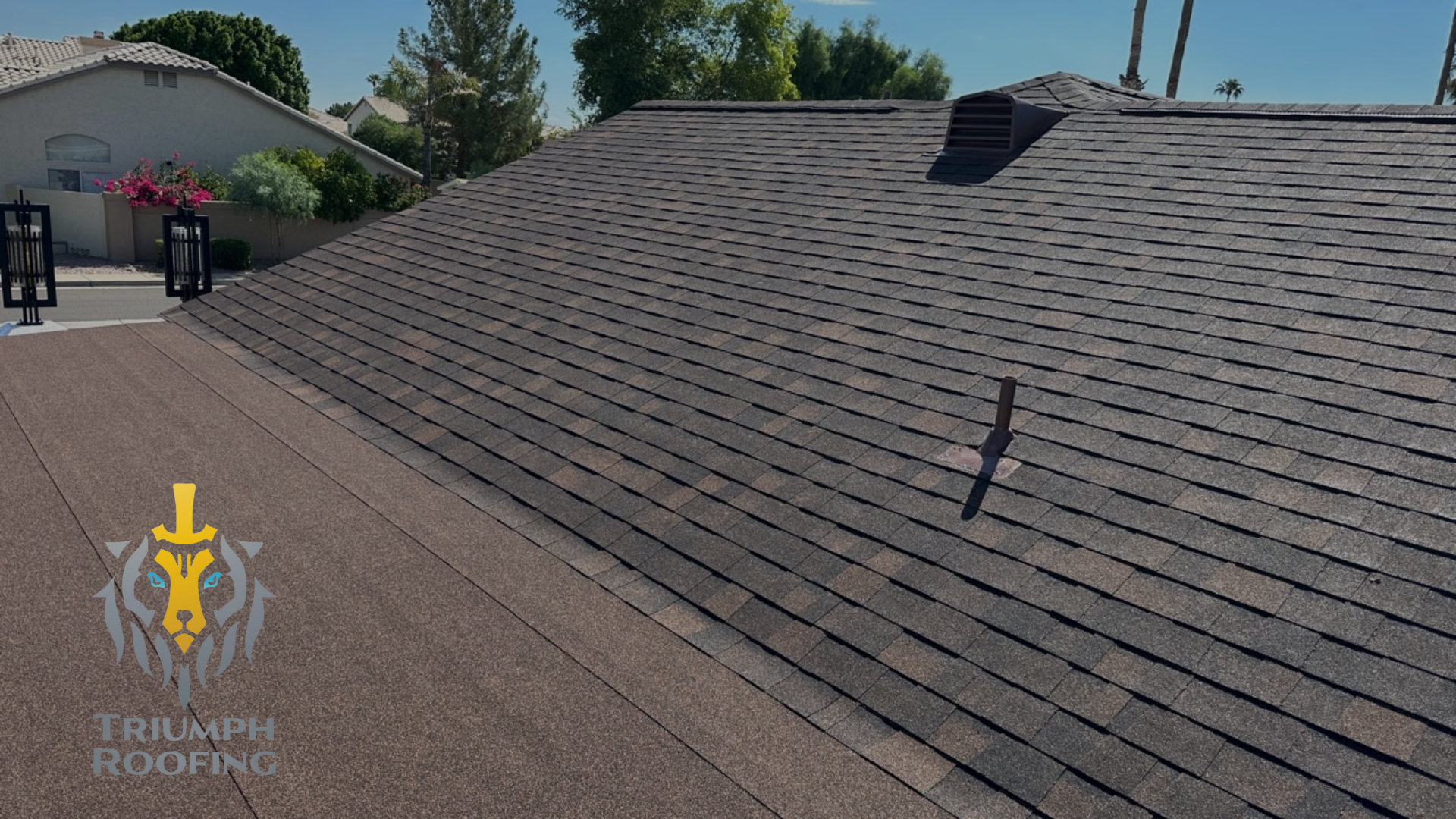
Importance of Roof Inspections Prior to Monsoon Season
Here in Arizona, we know what comes after the scorching summer sun: the unpredictable yet powerful monsoon season. While the downpours bring a relieving break from the heat, they can also wreak havoc on your roof if it’s unprepared. That’s why our team at Triumph Roofing urges homeowners to prioritize pre-monsoon roof inspections.
Why are Pre-Monsoon Roof Inspections Crucial?
A proactive approach to roof maintenance is the biggest key to protecting your Arizona home. Here’s how a pre-monsoon inspection with Triumph Roofing benefits your peace of mind and roof:
- Early Detection of Problems: Our team of roofers can easily identify potential issues before they escalate into major leaks or structural damage. This includes loose or missing shingles, deteriorated flashing, clogged gutters, and signs of wear and tear. Addressing these concerns early on saves you money on repairs in the future.
- Peace of Mind During Monsoon Season: Knowing your roof is in top condition provides peace of mind throughout the monsoon season. You can relax and enjoy the cooling rain without worrying about surprise leaks or water damage!
- Prevent Costly Repairs: Small problems left unattended can morph into expensive repairs later. A pre-monsoon inspection allows us to identify and address minor issues before they become major headaches (and wallet-drainers).
- Extended Roof Lifespan: Taking care of your roof ensures it lasts longer and performs optimally. Regular inspections and preventive maintenance can significantly extend the lifespan of your roof, saving you money on a full replacement in the long run.
- Improved Energy Efficiency: A well-maintained roof with proper ventilation and flashing contributes to your home’s energy efficiency. Fixing minor problems before the monsoon ensures your house stays cool and comfortable without unnecessary energy usage.
What Does a Pre-Monsoon Roof Inspection with Triumph Roofing Entail?
At Triumph Roofing, we take a comprehensive approach to roof inspections, especially before monsoon season. Here’s what you can expect:
- Thorough Visual Inspection: Our experienced roofers will conduct a detailed visual inspection of your roof, both from the ground and (if safe) on the roof itself. They will look for signs of existing damage, missing components, and potential weak points that could be affected by storms.
- Gutter and Downspout Check: Clogged gutters can lead to water pooling around your foundation, potentially causing leaks and structural issues. We will clear debris from your gutters and downspouts, ensuring proper drainage during heavy monsoon rains.
- Flashing Inspection: Flashing is a crucial component that seals around chimneys, vents, and other roof penetrations. We will inspect the flashing for signs of wear and tear, ensuring it’s in good condition to prevent leaks.
- Ventilation Assessment: Proper ventilation plays a vital role in preventing moisture buildup and promoting energy efficiency. We will assess your roof’s ventilation system and suggest improvements if necessary.
Why Choose Triumph Roofing for Your Pre-Monsoon Inspection?
When it comes to your roof, trust matters. Choosing Triumph Roofing for your pre-monsoon inspection offers several advantages:
- Experienced and Certified Roofers: Our team consists of highly qualified and certified roofers who possess extensive experience handling roofs throughout all of Arizona.
- Commitment to Quality: We use only top-quality materials and follow strict industry standards to ensure your roof is inspected and maintained with the utmost care.
- Competitive Pricing: We offer competitive rates for our roof inspections, making roof care accessible for every homeowner.
- Honest and Transparent Service: We believe in open communication and will clearly explain any issues we find on your roof and provide you with transparent recommendations for repairs or maintenance.
Schedule Your Pre-Monsoon Roof Inspection Today!
Don’t wait until monsoon season arrives to discover roof problems. Contact Triumph Roofing today to schedule your pre-monsoon inspection. We’ll ensure your roof is in top shape to handle the upcoming downpours, giving you peace of mind and protecting your investment throughout the rest of the season!
We Stay Prepared for Monsoon Season
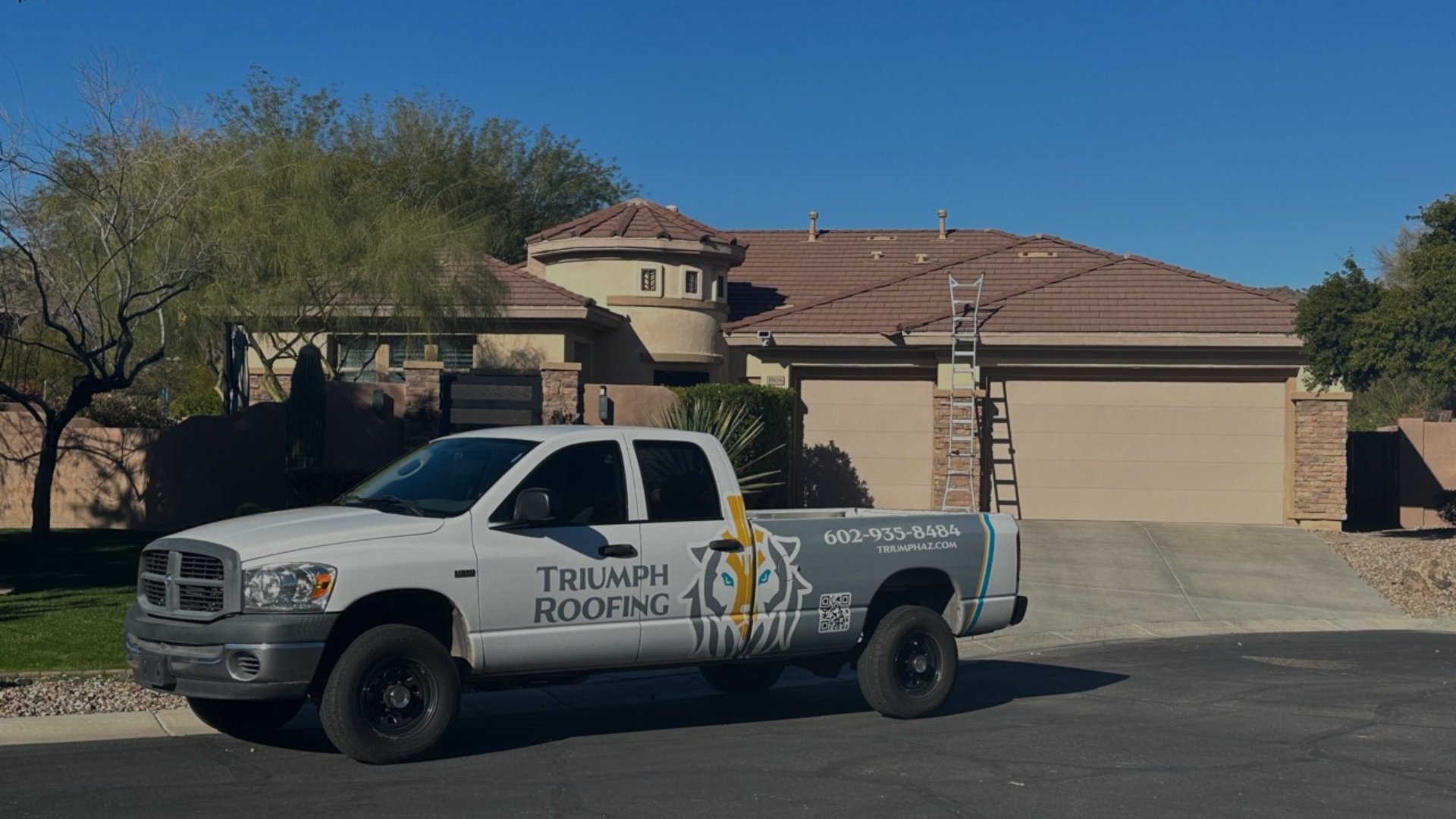
5 Ways to Prepare Your Roof for Monsoon Season
Monsoon season brings a welcome respite from the scorching summer heat, but these powerful storms can also wreak havoc on your roof. Heavy rain, strong winds, and hail can damage shingles, clog gutters, and lead to leaks, causing costly repairs and interior damage.
At Triumph Roofing, we know the importance of a strong, reliable roof. Here are our top 5 ways to prepare your roof for monsoon season.
1. Comprehensive Monsoon Season Roof Inspection
The first line of defense is a thorough roof inspection from qualified professionals. Our team at Triumph Roofing will conduct a detailed roof inspection, looking for:
- Missing or damaged shingles: Loose or cracked shingles are prime entry points for water. We’ll identify any problem areas and recommend repairs or replacements.
- Flashing issues: Flashing around chimneys, vents, and skylights is crucial for preventing leaks. We’ll ensure these areas are properly sealed and secure.
- Signs of wear and tear: Weathering, granule loss, and curling shingles indicate a roof nearing the end of its lifespan. We can advise on potential roof replacement needs.
- Debris accumulation: Leaves, branches, and other debris can trap moisture and damage shingles. We’ll clear your roof and recommend gutter cleaning services if needed.
2. Gutter Cleaning and Maintenance
Gutters play a vital role in directing rainwater away from your home’s foundation. Clogged gutters can overflow, causing leaks and foundation problems. We offer gutter cleaning services to ensure proper water flow. We’ll also inspect gutters for any damage or rust and recommend repairs if necessary.
3. Tree Branch Trimming
Overhanging branches pose a significant threat during monsoons. High winds can snap branches, causing them to fall and damage your roof. We recommend regular tree trimming by a qualified arborist to minimize this risk of any roof damages.
4. Roof Repair and Monsoon Season Maintenace
Based on our inspection, we can provide expert recommendations for any necessary repairs. Our skilled roofers can address issues like
- Replacing missing or damaged shingles
- Resealing flashing around chimneys, vents, and skylights
- Applying roof sealant to minor cracks or leaks
5. Roof Replacement
If your roof inspection reveals significant damage or your roof is nearing the end of its lifespan (typically 15-20 years for asphalt shingles), we can guide you through the roof replacement process. Our team at Triumph Roofing offers a variety of high-quality roofing materials and styles to meet your specific needs and budget.
Why Choose Triumph Roofing for Monsoon Season Preparation?
At Triumph Roofing, we understand the importance of peace of mind. Here’s what sets us apart:
- Experienced and Certified Professionals: Our team is highly trained and certified to handle all your roofing needs.
- Comprehensive Roof Inspections: We provide a detailed report outlining any issues and recommendations.
- High-Quality Materials and Workmanship: We use only the best materials and ensure top-notch workmanship for lasting results.
- Competitive Prices and Financing Options: We offer competitive pricing and flexible financing options to fit your budget.
- Commitment to Customer Satisfaction: Your satisfaction is our priority. We provide excellent customer service throughout the process.
Don’t wait until the monsoon hits! Take proactive steps to ensure your roof is ready for the season. Contact us today to schedule a free roof inspection and get a quote for any necessary repairs or maintenance. With Triumph Roofing by your side, you can weather any storm with confidence!
Get Social With Triumph Roofing
View this post on Instagram

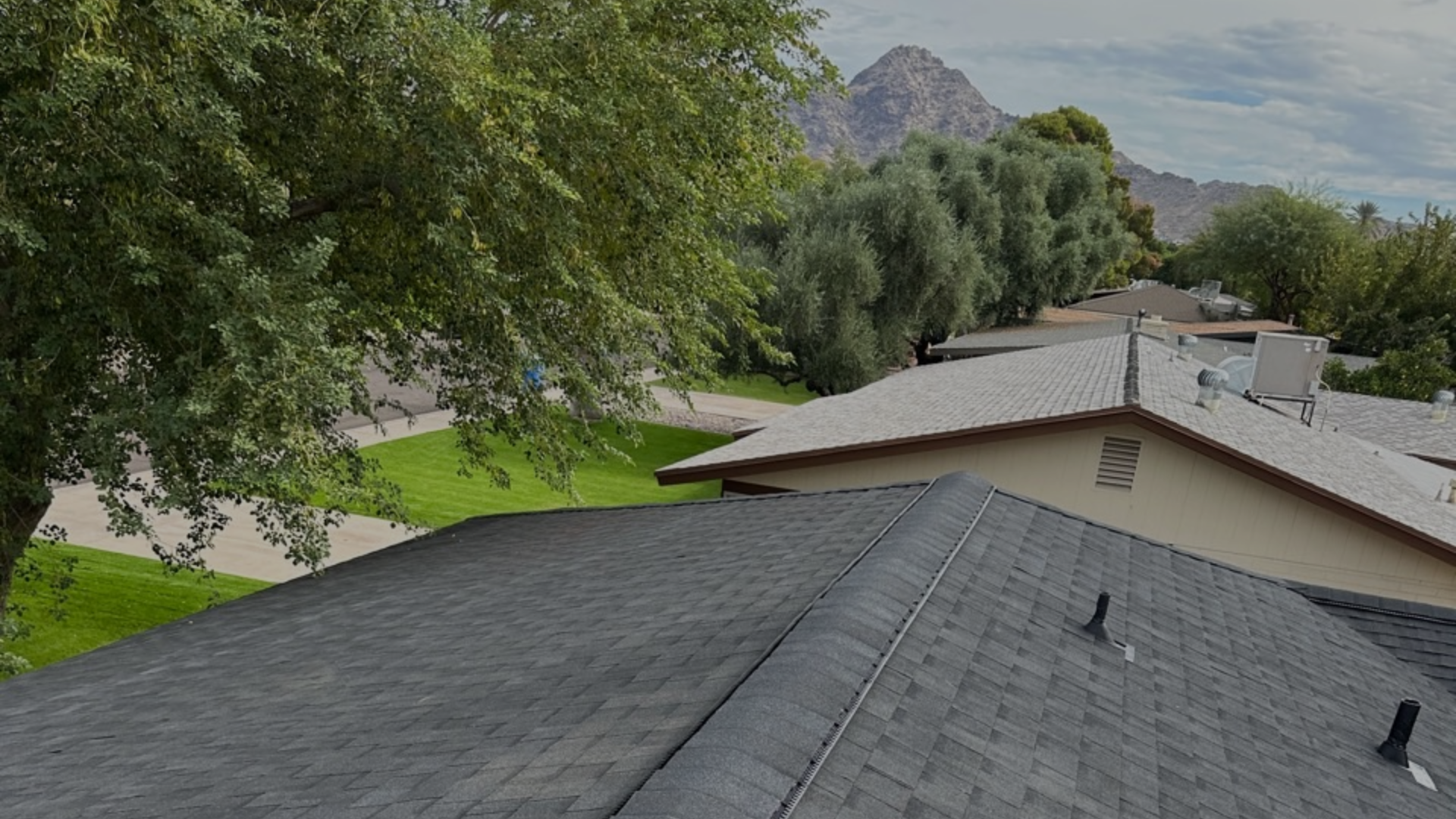
What to Expect During a Roof Inspection from Triumph Roofing
Your roof does indeed need occasional check-ups to ensure it remains in top form. Our professional roofers at Triumph Roofing understand the importance of proactive roof care. That’s why we offer comprehensive roof inspections that provide peace of mind and empower you to make informed decisions about your roof’s health.
So, what exactly happens during a roof inspection withTriumph Roofing?
Pre-Inspection Preparation

- Scheduling: If you are looking for a roof inspection, please contact us to schedule your inspection at your convenience. We offer flexible scheduling options to fit your busy life.
- Gathering Information: Before the inspection, we’ll ask you some questions about your roof’s age, history of repairs, and any recent concerns you might have. This information helps us tailor the inspection to your specific needs.
The Inspection
When we are conducting the actual roof inspection, we make sure and take the following into consideration:
- Safety First: Our certified inspectors prioritize safety. They’ll arrive equipped with proper safety gear and conduct a thorough visual assessment from the ground, looking for any immediate signs of trouble.
- Climbing Up for a Closer Look: When necessary, the inspector will safely climb onto your roof to perform a detailed examination. They’ll walk the entire roof surface, meticulously inspecting every inch.
- Flashing and Valleys: Special attention is given to vulnerable areas like flashing (the metal strips that seal roof joints) and valleys (where two roof slopes meet). These areas are prone to water infiltration and require close scrutiny.
- Shingles and Underlayment: The inspector will examine the condition of your shingles, looking for signs of cracking, curling, or missing shingles. The underlayment, the layer beneath the shingles, will also be assessed for any deterioration.
- Ventilation and Drainage Systems: Proper ventilation is crucial for preventing heat buildup and moisture damage. Vents and soffits (underside of the roof overhang) will be inspected for functionality. Additionally, gutters and downspouts, responsible for draining rainwater away from your home, will be checked for blockages or damage.
- Interior Signs: While the primary focus is on the exterior roof, the inspector may also check the attic or interior ceilings for signs of water leaks or moisture damage.
Post-Inspection Report and Recommendations
Prior to your roofing inspection, we will follow up with a detailed report so you can gain awareness of the condition of your roof. We will provide the following:
- Detailed Report: After the inspection, you’ll receive a comprehensive report outlining the inspector’s findings. This report will detail the condition of various roof components, along with photos of any areas of concern.
- Honest Recommendations: Based on the inspection, our experts will provide clear and honest recommendations. This may include minor repairs, preventive maintenance suggestions, or, if necessary, a discussion about potential roof replacement.
- Open Communication: We believe in open communication. Our inspectors are happy to answer any questions you have about the report and address your concerns.
Why Choose Triumph Roofing?
Our team comprises highly trained and certified inspectors who possess in-depth knowledge of all roofing systems. Our main value is prioritizing your needs and concerns. Our inspectors will explain everything in clear language, empowering you to make informed decisions about your roof.
At Triumph Roofing, quality is paramount. We use only top-of-the-line materials and employ the highest standards of workmanship. Contact one our team of roofing professionals today to get a roof inspection to ensure your roof quality. We always recommend getting your roof inspected prior to monsoon season.
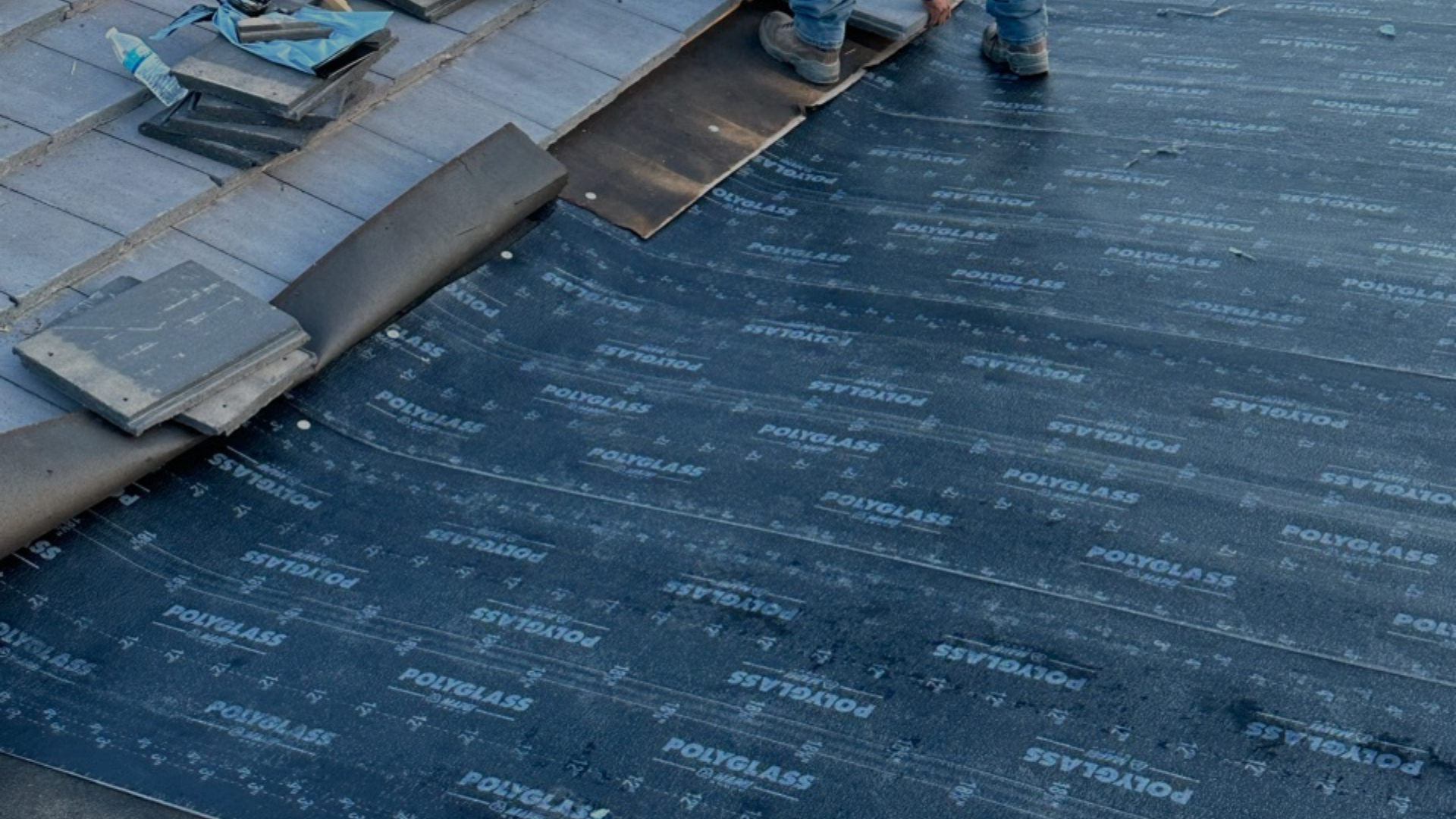
How Roof Underlayment Protects Your Home During Monsoon Season
As the summer heat grows stronger, Arizona monsoon season comes closer. Preparing for monsoon season as a homeowner is absolutely essential to your roof’s health. Here in the Valley of the Sun, we experience dramatic shifts from scorching heat to heavy downpours during monsoon season. A properly installed roof underlayment is vital for keeping your home safe from water damage.
What is Roof Underlayment?

Our roofing experts describe roofing underlayment as a protective barrier beneath your roof shingles or tiles. It’s a waterproof barrier, typically made of felt or synthetic materials, that sits directly on top of the roof deck (the structural base of your roof). Having a strong roof underlayment is essential to the integrity of the rest of your roof.
Why is Roof Underlayment Important During Monsoon Season?
While your roof shingles are the first line of defense against the monsoon rains, they aren’t perfect. Windblown rain can get underneath damaged shingles, and heavy downpours can overwhelm even the most robust shingle design. This is where your roof underlayment comes into play.
-
Waterproofing: A good quality underlayment acts as a secondary water barrier. Even if some water sneaks past your shingles, the underlayment channels it away from the roof deck and towards the gutters, preventing leaks and potential water damage to your home’s interior.
-
Secondary Defense: Monsoon storms can be unpredictable, and sometimes shingles can get blown off during high winds. A properly installed underlayment provides an extra layer of protection in these situations, preventing water from directly reaching the roof deck until repairs can be made.
-
Durability: Underlayment protects the roof deck from the elements, extending the lifespan of your entire roof system. Especially during the harsh Arizona sun, quality underlayment shields the roof deck from heat damage, which can cause warping and cracking over time.
Maintaining Your Roofing Underlayment
Just like your roof shingles, underlayment isn’t invincible. Here’s how to ensure it performs optimally during monsoon season:
-
Regular Roof Inspections: Schedule a professional roof inspection before monsoon season hits. A qualified roofer can identify any tears, punctures, or signs of wear and tear in the underlayment and recommend repairs if necessary.
-
Preventative Maintenance: Keep your gutters clean and free of debris throughout the year. Clogged gutters can lead to water pooling on the roof, which can damage the underlayment over time.
-
Material Matters: When it comes to underlayment, discuss options with your roofer. Synthetic underlayment is becoming increasingly popular due to their superior moisture resistance and durability compared to traditional felt underlayment.
Maintain Your Roof and Peace of Mind During Monsoon Season
A properly installed and maintained roof underlayment is a silent guardian, working tirelessly to protect your home from the relentless Arizona monsoon season. By taking some preventative measures and ensuring your underlayment is in good shape, you can face the storms with confidence, knowing your home is well-protected. Worried about the quality of your roof underlayment currently?
Contact one our team of roofing professionals today to get a roof inspection to ensure your roof quality. We always recommend getting your roof inspected prior to monsoon season.

We Care About Our Work!
We offer a 5-year workmanship warranty on all jobs done!
Because we care, we offer an extra warranty on top of any factory warranty that your supplies includes!
Some material manufacturers also offer a lifetime limited warranty.
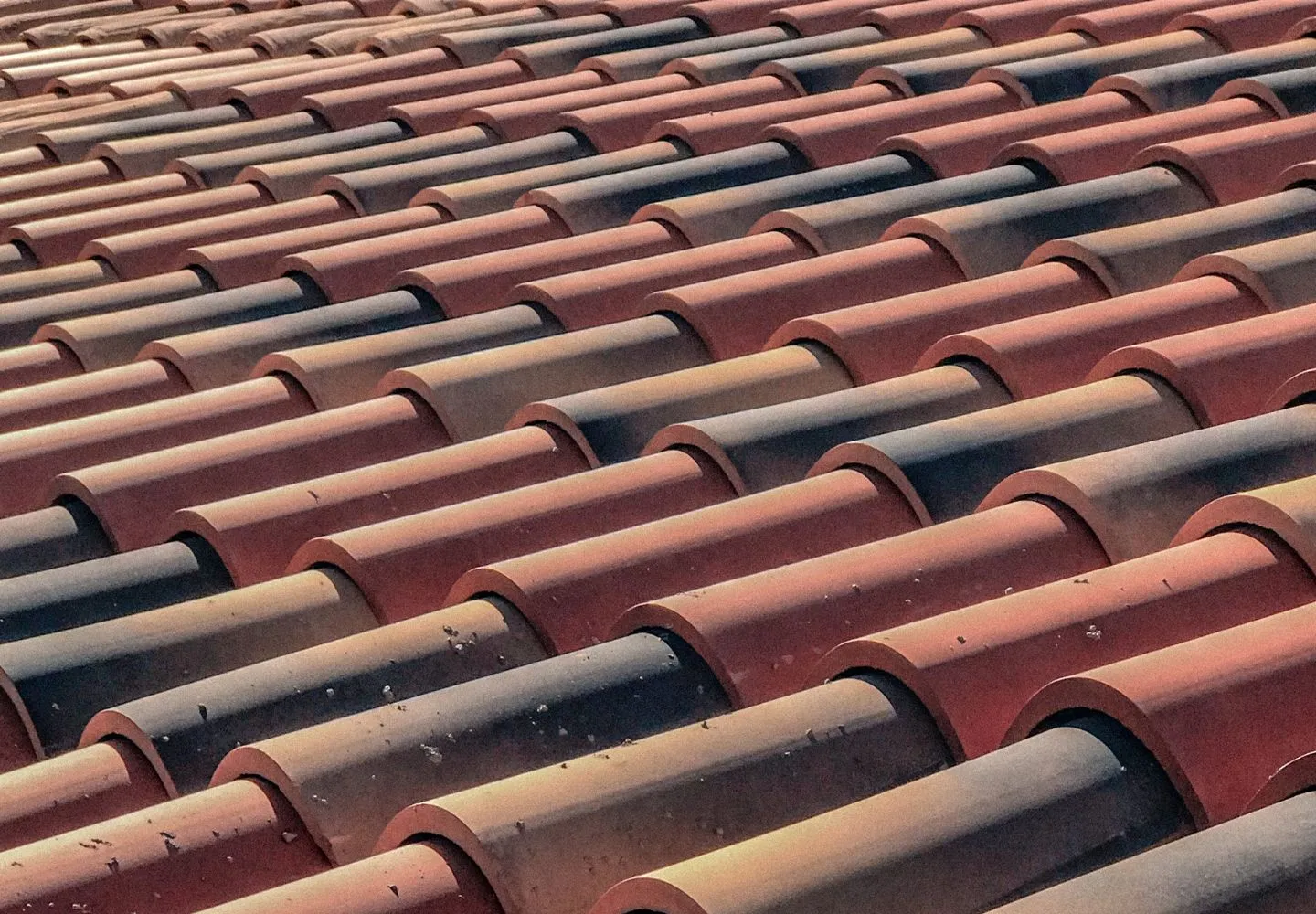
Tell us about your roofing needs.
"*" indicates required fields

